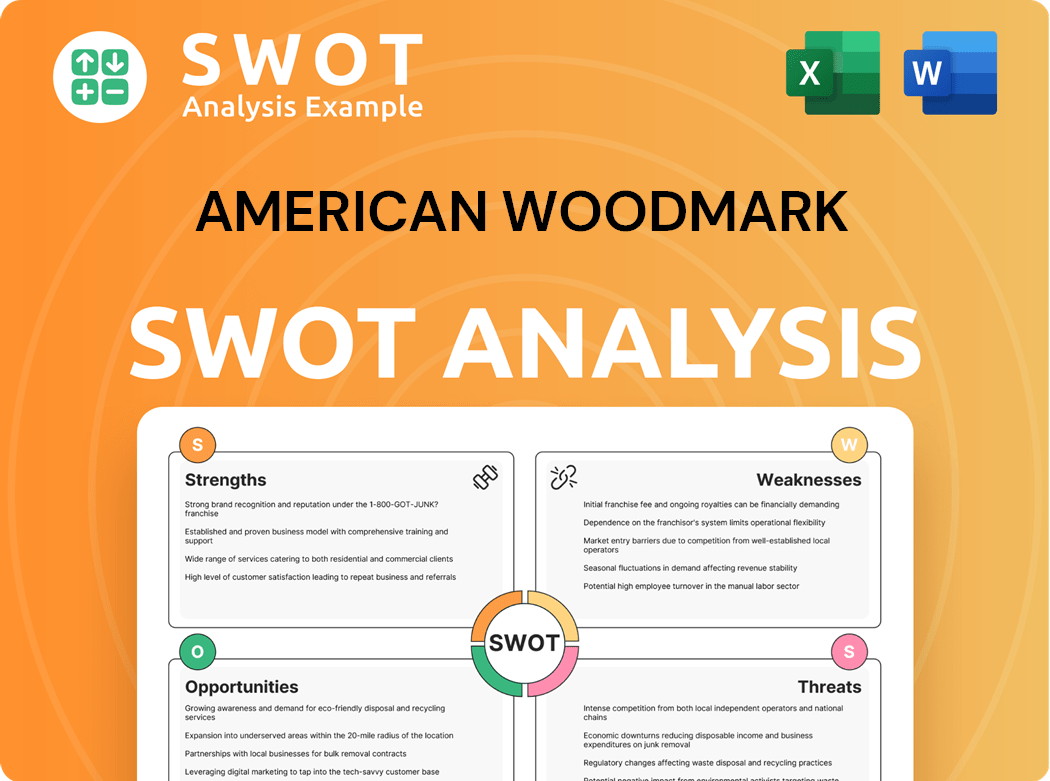American Woodmark Bundle
Who Really Controls American Woodmark?
Understanding the ownership structure of a company is crucial for investors and strategists alike. American Woodmark, a leading wood cabinet company, presents a compelling case study in corporate governance, beginning with its leveraged buyout in 1980. This deep dive into Woodmark ownership will reveal the key players shaping its future.

From its inception as an independent entity spun off from Boise Cascade, American Woodmark has evolved significantly. Today, with a market capitalization of $808 million as of June 6, 2025, and primarily institutional ownership, the American Woodmark SWOT Analysis becomes even more critical. This analysis will clarify the influence of major shareholders and their impact on the company's strategic direction, providing valuable insights into the Woodmark company profile and its position in the market. Exploring who owns Woodmark is key to understanding its trajectory.
Who Founded American Woodmark?
The story of American Woodmark began in 1980, marking a significant shift in the wood cabinet industry. The company was formed through a leveraged buyout, setting the stage for its future as a major player in the market. This pivotal moment involved a group of executives who saw the potential for a dedicated cabinet manufacturing enterprise.
The founders, Bill Brandt, Al Graber, Jeff Holcomb, and Don Mathias, acquired the cabinet division of Boise Cascade. This strategic move allowed them to establish a new company focused solely on cabinet production. At the time of its inception, the company was already substantial, employing over 1,100 team members and operating three manufacturing facilities.
Before the buyout, the roots of the business trace back to 1951 when Alvin Goldhush established Raygold Industries. Initially, Raygold produced cabinets for Goldhush's dental practice. Raygold was later acquired by Boise Cascade in April 1971. The 1980 buyout by the four executives marked the beginning of the modern American Woodmark.
The initial equity splits among the founders are not publicly available. However, their collective vision and financial backing were critical to the company's launch.
By 1999, co-founder William F. Brandt, Jr. was known to own approximately 30% of the company, indicating his significant early investment.
In 1986, the company went public, offering shares at $15 each, which provided a new avenue for investment and growth.
As of 2025, William F. Brandt is reported as the largest individual shareholder, owning 1.83 million shares.
Brandt's 1.83 million shares represent 12.37% of the company, demonstrating his continued significant stake.
The value of Brandt's holdings is approximately $106.21 million, highlighting the financial success of the company.
Understanding the
- The company started with a leveraged buyout in 1980.
- William F. Brandt, Jr. was a significant shareholder, owning about 30% in 1999.
- The company went public in 1986 at $15 per share.
- As of 2025, Brandt is the largest individual shareholder, with a 12.37% stake.
American Woodmark SWOT Analysis
- Complete SWOT Breakdown
- Fully Customizable
- Editable in Excel & Word
- Professional Formatting
- Investor-Ready Format

How Has American Woodmark’s Ownership Changed Over Time?
American Woodmark, a prominent wood cabinet company, went public in 1986. Its stock is traded on The NASDAQ Global Select Market under the symbol 'AMWD'. As of June 17, 2024, the company had approximately 27,500 shareholders, including 6,300 shareholders of record and 21,100 beneficial owners. This initial public offering marked a significant shift in Woodmark ownership, opening the door for broader investor participation.
The ownership structure of American Woodmark (AMWD) stock is currently a mix of institutional, retail, and individual investors. Institutional investors hold a significant portion of the shares. The company's history also includes strategic moves like the 2017 acquisition of RSI, which expanded its market reach. Further insights into the company's journey can be found in this Brief History of American Woodmark.
| Shareholder Type | Percentage of Shares Held (Approximate) | As of Date |
|---|---|---|
| Institutional Owners | Approximately 57.54% | March 31, 2025 |
| Mutual Funds | Increased from 74.31% to 74.47% | March 2025 |
Key institutional shareholders include BlackRock, Inc. (holding 2.5 million shares, valued at $147 million as of March 2025), The Vanguard Group Inc. (1.6 million shares, valued at $93 million as of March 2025), Dimensional Fund Advisors Lp (1.2 million shares as of December 2024), Cooke & Bieler Lp (892,000 shares as of March 2025), and Pzena Investment Management Llc (841,000 shares, with a 72% increase in holding as of March 2025). The company also engages in share buybacks, repurchasing 417,298 shares, or approximately 2.8% of shares outstanding, for $27.6 million during the fourth quarter of fiscal 2025. For the full fiscal year 2025, 1,169,710 shares, or approximately 7.5% of shares outstanding, were repurchased for $96.7 million. As of April 30, 2025, $117.8 million remained available for common stock repurchases.
The ownership of American Woodmark is primarily composed of institutional investors, with a significant portion held by major financial firms.
- Institutional investors hold a majority stake.
- The company has a history of share buybacks.
- The acquisition of RSI was a pivotal strategic move.
- Retail and individual investors also hold shares.
American Woodmark PESTLE Analysis
- Covers All 6 PESTLE Categories
- No Research Needed – Save Hours of Work
- Built by Experts, Trusted by Consultants
- Instant Download, Ready to Use
- 100% Editable, Fully Customizable

Who Sits on American Woodmark’s Board?
As of June 2025, the board of directors of American Woodmark includes M. Scott Culbreth (President and CEO), Vance W. Tang (Non-Executive Chairman), Latasha Akoma, Andrew B. Cogan, James G. Davis, Jr., Daniel T. Hendrix, David A. Rodriguez, Emily C. Videtto, and Philip D. Fracassa. James G. Davis, Jr. is retiring and will not stand for re-election at the next annual shareholders meeting after serving for 23 years. Philip Fracassa joined the Board of Directors in January 2024.
| Director | Title | |
|---|---|---|
| M. Scott Culbreth | President and CEO | |
| Vance W. Tang | Non-Executive Chairman | |
| Latasha Akoma | Director | |
| Andrew B. Cogan | Director | |
| James G. Davis, Jr. | Director | |
| Daniel T. Hendrix | Director | |
| David A. Rodriguez | Director | |
| Emily C. Videtto | Director | |
| Philip D. Fracassa | Director |
The voting structure for American Woodmark's common stock is generally one-share-one-vote. Each outstanding share of common stock entitles the owner to one vote on each matter presented at shareholder meetings. For uncontested elections, directors are elected by a majority of votes cast. A majority of the total outstanding shares entitled to vote constitutes a quorum for shareholder meetings.
M. Scott Culbreth, the CEO, directly owns 0.23% of the company's shares, valued at approximately $1.98 million as of June 2025. Other key insiders with reported holdings as of May 2025 include Vance W. Tang (0.36%), Robert J. Adams, Jr. (0.24%), Paul Joachimczyk (0.17%), James G. Davis, Jr. (0.15%), and Dwayne L. Medlin (0.08%). Insiders collectively increased their holdings from 1.99% to 2.19% in May 2025.
- The board of directors is responsible for overseeing the company's operations.
- Shareholders vote on important matters, including the election of directors.
- Insider ownership provides insight into the alignment of interests between management and shareholders.
- Knowing the Woodmark ownership structure is crucial for investors.
American Woodmark Business Model Canvas
- Complete 9-Block Business Model Canvas
- Effortlessly Communicate Your Business Strategy
- Investor-Ready BMC Format
- 100% Editable and Customizable
- Clear and Structured Layout

What Recent Changes Have Shaped American Woodmark’s Ownership Landscape?
Over the past few years, American Woodmark has seen shifts in its ownership structure and strategic direction. The company continued its share buyback program, repurchasing a significant number of shares. In the fourth quarter of fiscal 2025, 417,298 shares were bought back for $27.6 million. For the entire fiscal year 2025, a total of 1,169,710 shares were repurchased for $96.7 million. As of April 30, 2025, there was $117.8 million authorized for future share repurchases.
Leadership changes have also occurred. James G. Davis, Jr. announced he would not seek re-election to the Board of Directors in May 2025, ending his 23 years of service. Philip Fracassa joined the Board of Directors in January 2024. These changes reflect the ongoing evolution of the company's governance and leadership.
| Metric | May 2025 | Previous Months |
|---|---|---|
| Institutional Ownership | Approximately 95.20% | Unchanged |
| Mutual Fund Holdings | 74.47% (March 2025) | 74.31% |
| Insider Holdings | 2.19% | 1.99% |
From an industry perspective, the institutional ownership of Woodmark ownership remains high, with about 95.20% held by institutional investors in May 2025. Mutual fund holdings saw a slight increase, and insider holdings also rose. Despite challenges in the housing market, the company anticipates a sales recovery in the second half of fiscal 2026. This is expected to be driven by new product launches, facility expansions, and operational improvements. American Woodmark is also focusing on automation and digital transformation. Learn more about the company by exploring the Revenue Streams & Business Model of American Woodmark.
The company is a significant player in the wood cabinet company industry. It has a history of strategic adjustments in response to market dynamics. The company is focused on operational efficiencies and growth.
Institutional investors hold a substantial portion of the company's shares. Mutual funds and insiders also have ownership stakes. These ownership patterns are key to understanding the company.
The company's stock symbol is relevant for investors. Investors can monitor the stock price and company financials. The company's annual reports provide detailed financial information.
Changes in leadership and strategic initiatives are important. The company's focus includes new product launches. Facility expansions and operational improvements are also key.
American Woodmark Porter's Five Forces Analysis
- Covers All 5 Competitive Forces in Detail
- Structured for Consultants, Students, and Founders
- 100% Editable in Microsoft Word & Excel
- Instant Digital Download – Use Immediately
- Compatible with Mac & PC – Fully Unlocked

Related Blogs
- What are Mission Vision & Core Values of American Woodmark Company?
- What is Competitive Landscape of American Woodmark Company?
- What is Growth Strategy and Future Prospects of American Woodmark Company?
- How Does American Woodmark Company Work?
- What is Sales and Marketing Strategy of American Woodmark Company?
- What is Brief History of American Woodmark Company?
- What is Customer Demographics and Target Market of American Woodmark Company?
Disclaimer
All information, articles, and product details provided on this website are for general informational and educational purposes only. We do not claim any ownership over, nor do we intend to infringe upon, any trademarks, copyrights, logos, brand names, or other intellectual property mentioned or depicted on this site. Such intellectual property remains the property of its respective owners, and any references here are made solely for identification or informational purposes, without implying any affiliation, endorsement, or partnership.
We make no representations or warranties, express or implied, regarding the accuracy, completeness, or suitability of any content or products presented. Nothing on this website should be construed as legal, tax, investment, financial, medical, or other professional advice. In addition, no part of this site—including articles or product references—constitutes a solicitation, recommendation, endorsement, advertisement, or offer to buy or sell any securities, franchises, or other financial instruments, particularly in jurisdictions where such activity would be unlawful.
All content is of a general nature and may not address the specific circumstances of any individual or entity. It is not a substitute for professional advice or services. Any actions you take based on the information provided here are strictly at your own risk. You accept full responsibility for any decisions or outcomes arising from your use of this website and agree to release us from any liability in connection with your use of, or reliance upon, the content or products found herein.